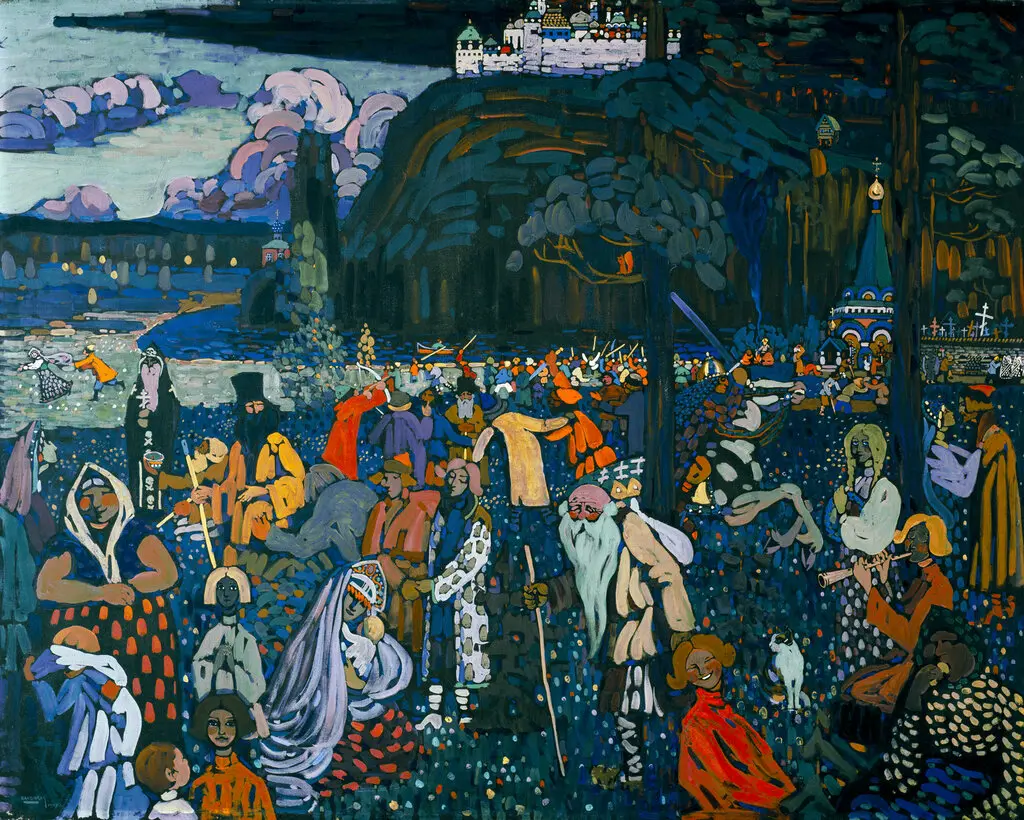News:
German Panel Says Kandinsky Painting Should Go Back to Jewish Heirs
By Catherine Hickley
The decisions of the government panel, which handles claims about art lost or looted in the Nazi-era, are not legally binding, but are nearly always followed.

“Colorful Life” (1907) by Wassily Kandinsky, which is currently on loan from a Bavarian state bank to a museum in Munich
The German government’s advisory panel on Nazi-looted art has recommended a vibrant tempera painting by Wassily Kandinsky be returned to the heirs of a Jewish family who suffered persecution under the Nazis in the Netherlands during World War II.
The painting, “Colorful Life,” from 1907, was part of an extensive art collection belonging to Emanuel Albert Lewenstein, the director of a sewing machine factory, and his wife, Hedwig Lewenstein Weyermann. It is thought to have been on loan from the family to the Stedelijk Museum in Amsterdam when the Germans invaded the Netherlands in 1940 and was auctioned off in October of that year.
Since 1972 it has been hanging in a museum in Munich, the Städtische Galerie im Lenbachhaus, on loan from a state-owned bank, BayernLB.
By the time of auction in Amsterdam, the Lewensteins had died and their two surviving children had fled Europe. Despite years of research, it has not been possible to ascertain the circumstances of the sale, nor even to identify who put the painting up for auction.
But the German advisory commission said Tuesday that, whether through sales or confiscation, art losses experienced by people from persecuted groups in the Nazi-occupied Netherlands should be assumed to have been involuntary — and therefore eligible for restitution — unless there is clear evidence to the contrary.
“There are numerous indications that this was a case of a seizure as a result of Nazi persecution,” the commission said. “The systematic exclusion, disenfranchisement and dispossession of the Jewish population of the Netherlands began immediately after the invasion of the German Wehrmacht on May 10, 1940.”
“Colorful Life” is considered an important moment in Kandinsky’s journey from figurative painting to abstraction. A host of characters in traditional Russian dress dance, embrace, play, pray, beg or fight in a dreamlike landscape: In the background, a white onion-domed citadel gleams over a river from the top of a blue mountain shaped like a boulder.
“For ‘Colorful Life,’ where the appealing central task was to bring together a jumble of masses, spots and lines, I used a ‘bird’s eye’ perspective so that I could put the figures on top of each other,” Kandinsky wrote later.
He identified it as one of three paintings that — at the time they were produced, subconsciously — expressed a hallucination he experienced when young and ill with fever. Of the other two, “Arrival of the Merchants” (1905) depicts the figures with more precision, while the later work, “Composition II” (1910), is much more abstract.
The bank had argued that the painting was voluntarily consigned to auction by Irma Lewenstein Klein, the estranged wife of Robert Lewenstein, who remained in Amsterdam. But it could provide no proof, and the advisory commission pointed out that Irma, too, suffered persecution as a Jew, so even if she had sold it, the panel would be compelled to assume, under German guidelines, that the sale was made under duress.
Another question mark hangs over whether Hedwig Lewenstein had bequeathed the painting solely to Robert Lewenstein or to both her children. But the heirs of both Hedwig Lewenstein and Irma Lewenstein Klein have agreed on a distribution of shares in any paintings from the 1940 auction they recover.
That eliminates the need to determine “whether the contractual agreement that they reached among themselves reflects the actual circumstances under inheritance law,” the panel said.
The heirs, represented by Mondex Corporation, welcomed what James Palmer, its founder, described as a “wise and well-founded recommendation.”
Francesca Davis, the granddaughter of Hedwig and Emanuel Lewenstein said in a statement: “My late parents and grandparents would be extremely pleased about the decision in this matter.”
In 2021, the Lewenstein heirs recovered another Kandinsky work lost under the same murky circumstances and sold at the same 1940 auction.
The restitution of the 1909 work “Painting With Houses” ended a bitter, drawn-out dispute between the heirs and the city of Amsterdam. The city had balked at the Lewenstein claim and its position was supported by the Dutch Restitutions Committee, the national panel that makes advisory recommendations in the Netherlands.
The panel’s recommendation drew furious responses from groups representing claimants and eventually led to reforms of the Dutch Restitutions Committee and new national guidelines for returning Nazi-looted art.
These now stipulate that “if the original owner was a private individual belonging to a persecuted group, involuntary expropriation is presumed if it occurred in the Netherlands after 10 May 1940.”
.


